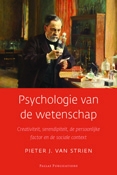Creativity and serendipity in science

Amsterdam University Press recently published a book entitled ‘Psychologie van de wetenschap. Creativiteit, serendipiteit, de persoonlijke factor en de sociale context.’ (‘A Psychology of Science. Creativity, serendipity, the personal factor and social context’). The author is Pieter J. van Strien, professor emeritus of psychology at the University of Groningen. This work is the only up-to-date book about the psychology of creativity and psychobiography written in the Dutch language. It pays special attention to the personal sources of creativity and their biographical roots.
The surprising part of the book is that it not only analyzes and illustrates creativity by means of examples, but it also puts it into perspective. The magical allure of ‘unexplained genius’ is offset against the reality of pure brainwork and reaction to coincidence. The book contains many examples designed to put the traditional view of creativity into a different perspective. The links it makes with schools of thought from the philosophy and sociology of science also take the reader by surprise. There is constant reference to historical discoveries, and new light is shed on underlying rivalry and ‘pseudo-creativity’ (fraud, plagiarism).
Major discoveries
As a background to his book, Van Strien sketches a broad picture of recent research into creativity in general, and explains how the current theories came about. He shows how most major historical discoveries are the result of long, patient hard work, even in cases where it seems like the creative solution suddenly springs to mind in a eureka moment. Chance discoveries (serendipity) are only imparted to ‘well-prepared minds’, putting the myth of unexplained creative genius into a completely different perspective. It also appears that many fundamental historical discoveries can be replicated by means of a fairly simple computer program. On the basis of this, the author takes the reader on a detailed exploration of ‘human surplus’ over and above computer creativity.
Breakthroughs
‘Revolutionary’ breakthroughs are the final step in a gradual train of thought that has taken generations to conceive, rather than a vision concocted by a select few. The Copernican revolution and the mechanical view of the world that started to emerge in the seventeenth century are good examples. In this respect, the book once again sheds a more down-to-earth light on the myth of the solitary creative genius. The same is true of the renowned ‘paradigm shifts’ described by philosopher of science Thomas Kuhn.
Rivalry, fraud and plagiarism
The author puts a different slant on findings from the sociology of science. It seems that many discoveries are made by a number of researchers simultaneously (‘multiples’). The resulting rivalry and battle for recognition often lead to fraud and plagiarism as the researchers do everything within their power to uphold the illusion of creativity. Van Strien cites countless examples to illustrate this point.
Psychobiography
In addition to the historical and social context, much emphasis is put on the personal aspect: the characteristics of a creative person and the life experiences that may be biographically relevant in terms of a researcher’s ability to generate creative ideas. A link is made between the life and work of the leading lights in the fields of science (Newton, Faraday, Bohr, Heisenberg), psychology (William James) and sociology (Max Weber). In his analyses, Van Strien pays specific attention to the role of psychobiography, which has become increasingly prominent over the last few decades. However, there is no mention of the one-sided Freudian school of thought that prevailed until fairly recently.
Curriculum vitae
Pieter van Strien (1928) is emeritus professor of psychology with an additional appointment to the Faculty of Philosophy at the University of Groningen. He has had countless articles on a variety of subjects within his field published. The creativity issue has fascinated him throughout his career. He now finds himself with more time to reap the harvest of his years of contemplation, and is presenting his ideas in a way that is easy to understand, even by people lacking specialist knowledge.
Note for the press
Information: Amsterdam University Press: www.aup.nl
More news
-
07 October 2025
What art does to us
